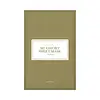What's inside
What's inside
 Key Ingredients
Key Ingredients

No key ingredients
 Benefits
Benefits

 Concerns
Concerns

No concerns
 Ingredients Side-by-side
Ingredients Side-by-side

Artemisia Princeps Extract 93.31%
Skin ConditioningButylene Glycol
Humectant1,2-Hexanediol
Skin ConditioningWater
Skin ConditioningDipropylene Glycol
HumectantGlycerin
HumectantHydroxyacetophenone
AntioxidantCarbomer
Emulsion StabilisingArginine
MaskingDipotassium Glycyrrhizate
HumectantHydrolyzed Hyaluronic Acid
HumectantPvm/Ma Copolymer
Emulsion StabilisingCaramel
Cosmetic ColorantJuniperus Mexicana Oil
MaskingVetiveria Zizanoides Root Oil
MaskingElettaria Cardamomum Seed Oil
MaskingAbies Sibirica Oil
MaskingDextrin
AbsorbentArtemisia Princeps Extract 93.31%, Butylene Glycol, 1,2-Hexanediol, Water, Dipropylene Glycol, Glycerin, Hydroxyacetophenone, Carbomer, Arginine, Dipotassium Glycyrrhizate, Hydrolyzed Hyaluronic Acid, Pvm/Ma Copolymer, Caramel, Juniperus Mexicana Oil, Vetiveria Zizanoides Root Oil, Elettaria Cardamomum Seed Oil, Abies Sibirica Oil, Dextrin
Water
Skin ConditioningGlycerin
HumectantButylene Glycol
HumectantParaffinum Liquidum
EmollientAspergillus/Rice Ferment Extract
HumectantGalactomyces Ferment Filtrate
HumectantSaccharomyces/Xylinum/Black Tea Ferment
Skin ConditioningPolysorbate 80
EmulsifyingSorbitan Sesquioleate
EmulsifyingCarbomer
Emulsion StabilisingXanthan Gum
EmulsifyingDimethicone
EmollientTromethamine
BufferingDisodium EDTA
Allantoin
Skin ConditioningDipotassium Glycyrrhizate
Humectant1,2-Hexanediol
Skin ConditioningPropanediol
SolventCaprylyl Glycol
EmollientIllicium Verum Fruit Extract
PerfumingChlorphenesin
AntimicrobialPhenoxyethanol
PreservativeParfum
MaskingWater, Glycerin, Butylene Glycol, Paraffinum Liquidum, Aspergillus/Rice Ferment Extract, Galactomyces Ferment Filtrate, Saccharomyces/Xylinum/Black Tea Ferment, Polysorbate 80, Sorbitan Sesquioleate, Carbomer, Xanthan Gum, Dimethicone, Tromethamine, Disodium EDTA, Allantoin, Dipotassium Glycyrrhizate, 1,2-Hexanediol, Propanediol, Caprylyl Glycol, Illicium Verum Fruit Extract, Chlorphenesin, Phenoxyethanol, Parfum
 Reviews
Reviews

Ingredients Explained
These ingredients are found in both products.
Ingredients higher up in an ingredient list are typically present in a larger amount.
1,2-Hexanediol is a synthetic liquid and another multi-functional powerhouse.
It is a:
- Humectant, drawing moisture into the skin
- Emollient, helping to soften skin
- Solvent, dispersing and stabilizing formulas
- Preservative booster, enhancing the antimicrobial activity of other preservatives
Butylene Glycol (or BG) is used within cosmetic products for a few different reasons:
Overall, Butylene Glycol is a safe and well-rounded ingredient that works well with other ingredients.
Though this ingredient works well with most skin types, some people with sensitive skin may experience a reaction such as allergic rashes, closed comedones, or itchiness.
Learn more about Butylene GlycolCarbomer is a polymer of acrylic acid. Its main role is to create a gel consistency.
A high amount of carbomer can cause pilling or balling up of products. Don't worry, most products contain 1% or less of carbomer.
Dipotassium Glycyrrhizate comes from licorice root.
Extracts of licorice have demonstrated to have antibacterial, anti‐inflammatory, antiviral, antioxidant properties.
One component, glabridin, has extra potent antioxidant and soothing properties. It has also been found to block pigmentation from UVB rays in guinea pigs.
Licorice Root also contains a flavonoid. Flavonoids are a natural substance from in plants. Flavonoids also have antioxidant properties.
Another component, glycyrrhizin, has been found to have anti-inflammatory and antimicrobial benefits. This may make licorice root extract effective at treating acne. However, more research is needed to support this.
Liquiritin is one of the flavone compounds found in licorice. It has been found to help lighten skin by preventing tyrosinase from reacting with tyrosine. When the two react, protein is converted to melanin. Melanin is the substance in your body that gives your features pigmentation.
Licorice root is native to Southern Europe and Asia. It has been used in traditional Chinese medicine to help with respiratory issues.
Learn more about Dipotassium GlycyrrhizateGlycerin is already naturally found in your skin. It helps moisturize and protect your skin.
A study from 2016 found glycerin to be more effective as a humectant than AHAs and hyaluronic acid.
As a humectant, it helps the skin stay hydrated by pulling moisture to your skin. The low molecular weight of glycerin allows it to pull moisture into the deeper layers of your skin.
Hydrated skin improves your skin barrier; Your skin barrier helps protect against irritants and bacteria.
Glycerin has also been found to have antimicrobial and antiviral properties. Due to these properties, glycerin is often used in wound and burn treatments.
In cosmetics, glycerin is usually derived from plants such as soybean or palm. However, it can also be sourced from animals, such as tallow or animal fat.
This ingredient is organic, colorless, odorless, and non-toxic.
Glycerin is the name for this ingredient in American English. British English uses Glycerol/Glycerine.
Learn more about GlycerinWater. It's the most common cosmetic ingredient of all. You'll usually see it at the top of ingredient lists, meaning that it makes up the largest part of the product.
So why is it so popular? Water most often acts as a solvent - this means that it helps dissolve other ingredients into the formulation.
You'll also recognize water as that liquid we all need to stay alive. If you see this, drink a glass of water. Stay hydrated!
Learn more about Water